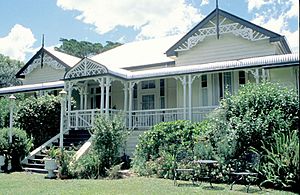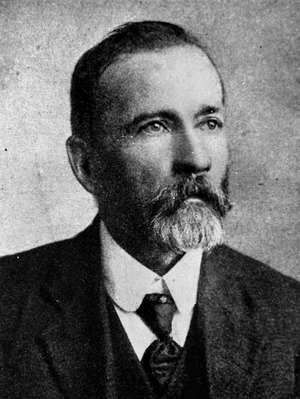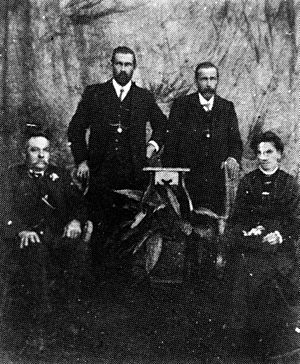St Isidore's facts for kids
Quick facts for kids St Isidore's |
|
|---|---|

St Isidore's, 1998
|
|
| Location | 40 Post Office Road, Mapleton, Sunshine Coast Region, Queensland, Australia |
| Design period | 1900–1914 (early 20th century) |
| Built | c. 1900–c. 1913 |
| Official name: St Isidore's, Mapleton Homestead, Seaview House, St Isidore's Farm College | |
| Type | state heritage (built) |
| Designated | 28 July 2000 |
| Reference no. | 601467 |
| Significant period | 1900s–1910s (fabric) 1900s–1940s (historical) |
| Significant components | trees/plantings, garden/grounds, farmhouse |
| Builders | James Blair Cramb |
| Lua error in Module:Location_map at line 420: attempt to index field 'wikibase' (a nil value). | |
St Isidore's is a historic house in Mapleton, Queensland, Australia. It is also known as Mapleton Homestead, Seaview House, and St Isidore's Farm College. This large timber home was built between about 1900 and 1913 by James Blair Cramb. It was added to the Queensland Heritage Register on 28 July 2000 because of its important history.
Contents
The History of St Isidore's House
This big timber house was built in the early 1900s. It was made for William James Smith and his family. They were early fruit farmers in Mapleton. Their farm was called Seaview Orchard.
In 1923, the Roman Catholic Archbishop of Brisbane, Rev. James Duhig, bought the orchard. He wanted to start a farming school called St Isidore's Farm College. The Church owned the land until the 1950s, but the school was never built.
The Smith Family and Mapleton's Beginnings
William James Smith and his brother Thomas David were the first to claim land in Mapleton. They were very important to fruit-growing in Queensland. The brothers came to Queensland from England in 1880. Their parents started a banana and strawberry farm.
In 1889, WJ and TD Smith explored the Blackall Range. They were looking for land to grow bananas. Before this, the area was mostly used for logging trees. It was hard to get to Mapleton back then. The only way was by walking.
The Smith brothers chose land near Mapleton Falls. In 1890, they began clearing Thomas's land. They sold the timber and built a simple house. Their sister Amy came to help them. By 1891, they had planted bananas and other crops. They also helped build a track for horses into the area.
Farming in Mapleton: From Bananas to Citrus
Other settlers came to Mapleton in the early 1890s. Bananas were the first crop. But prices were low, and it was hard to transport the fruit. So, the Smith brothers started growing citrus fruits like oranges. They also planted strawberries between the citrus trees. Strawberries were a good crop to sell quickly.
In 1891, WJ Smith married Sarah Anne Imogene Collins. They moved back to the Blackall Range. In 1892, Smith chose the land for Seaview Orchard. It was almost 160 acres of thick forest. Around the same time, David J Williams, who married Amy Smith, also chose land nearby.
For a short time, the area was called Luton Vale. But in 1894, the settlers chose the name Mapleton. WJ Smith suggested this name.
Building Seaview House
Most Mapleton settlers lived in simple huts at first. By 1897, the Smith family still lived in a small, four-room timber house. They had cleared about 8 acres of their land for fruit trees. WJ Smith received the official ownership of his land in 1898.
By 1900, Mapleton was becoming a major fruit-growing area. The Smiths were the main citrus growers. Seaview Orchard had over 1,000 fruit trees by 1903. They also grew many strawberries.
The first part of Seaview House was likely built by 1906. In that year, the Smiths hosted the Queensland Governor, Lord Chelmsford, at their farm. The house was described as "beautiful." This suggests it was much more than a simple hut.
A photo from 1911 shows the main part of the house. It had two front gables and verandahs. The house started with 6 rooms and was made bigger to 10 rooms around 1913. The fancy pressed metal designs inside the house might have been added then. A later photo from around 1915-16 shows the house looking much like it does today.
The timber for the house probably came from a local sawmill. James Blair Cramb built Seaview House. He married the Smiths' daughter, Florrie, in 1912. He also built a similar house for the Williams family, who were neighbours and relatives.
Mapleton's Growth and the Smiths' Legacy
By the early 1910s, Mapleton was a thriving farming area. It was known for citrus, bananas, and dairy farming. In 1914-1915, a tramline was extended to Mapleton. This helped fruit growers transport their produce. Seaview Orchard became very famous.
The WJ Smiths were important leaders in their community. They helped many new farmers. William was involved in many local groups, like the School Committee. Annie Smith was known for her community work, especially during World War I.
In 1919, the Smiths retired from farming. They sold Seaview Orchard and moved to Brisbane. The community gave them a big farewell. They later moved to Maroochydore.
St Isidore's Farm College: A Dream Unfulfilled
In 1919, James Miller bought Seaview Orchard. In 1923, he sold it to Archbishop James Duhig. The sale included Seaview House. Duhig wanted to create a Catholic agricultural college there. He planned to add a dormitory to the house. He even hired a farm manager. The property was renamed St Isidore's Farm College.
However, the church leaders in Brisbane did not support Duhig's plan. They would not pay for the college. Duhig also could not find a religious group to run the school. The farm manager was left without enough help or money. The once-great orchard started to fall apart.
By 1947, the farm was in bad shape. There were no crops or animals, and the houses needed repairs. A new group, the National Catholic Rural Movement, tried to restart the college. They planted new crops and made plans for growing trees. But again, the college did not happen.
In 1951, Duhig sold the property. It was used as a private farm until the late 1960s. Mapleton then became more of a residential and tourist area.
By 1980, Seaview House was on a much smaller block of land. It was known as Mapleton Homestead in the 1980s. It was a private home, then a guest house. In 1995, new owners bought it. They made it a family home again and renamed it St Isidore's. The front garden has changed, but some old trees remain.
What St Isidore's Looks Like
St Isidore's is a large timber house on the eastern edge of the Blackall Range. From the eastern rooms and verandahs, you can see amazing views. You can look over the Maroochy Plains all the way to the Pacific Ocean.
The house is made of timber. Most of its outside walls are covered with weatherboards. The part of the house added later has different timber cladding. The house looks very nice from the outside. It has a complex roof with corrugated iron. It also has decorative timber on its verandahs and gables (the triangular parts of the roof).
The house has verandahs at the front and sides. A small gabled entrance porch is at the front. There is decorative timber lattice on the gables. The eastern verandah has been closed in. But the front and western verandahs still have their original timber details. These include posts with brackets and a simple railing. A newer deck on the eastern side has a similar gabled entrance.
The back of the house has been changed a few times. A bathroom and a breakfast room were added. There is also a conservatory (a glass room) at the back. The rest of the backyard has a swimming pool and a garage.
Inside, the house looks a bit uneven. This is because it was built in at least two stages. But you can still see the original layout from around 1915-16. Some walls have been removed to create larger rooms. Each of the four bedrooms now has its own bathroom.
The inside of the house is special because of its many decorative pressed metal ceilings. These are found in almost every room. They include ceilings, cornices (decorative strips), and dados (lower wall panels). Many of the designs are in the Art Nouveau style. One design in the entrance hall is from an old catalogue. There is also pressed metal on the outside of a bay window.
The house also has a lot of early 20th-century coloured glass. You can see it in windows, doors, and fanlights (windows above doors). There is even a coloured glass screen between the entrance and the hallway.
One big change inside is in the eastern part of the house. Two walls were removed to make one large living room. But the pressed metal ceilings from the original rooms are still there. This shows how the rooms used to be. Large windows in this room offer great views of the ocean.
The inside of the house has been painted. Some floors have new timber laid over the old ones.
The property has several old trees. These might be part of the original garden from the early 1900s.
Why St Isidore's is a Heritage Site
St Isidore's was added to the Queensland Heritage Register on 28 July 2000. This means it is an important historical place.
- It shows how Queensland's history developed.
St Isidore's was the main house on Seaview Orchard. It shows how the Blackall Range became a major fruit-growing area in the early 1900s.
- It is a rare example of Queensland's history.
It is one of the few large, old homes left in the Blackall Range area from that time.
- It shows what a typical old rural house was like.
The house shows the main features of a big, well-built country home from the early 1900s.
- It is beautiful.
It has a beautiful design with gables and wide verandahs. These were built to catch the breezes and enjoy the views. The house also has many decorative pressed metal panels and coloured glass. It is set in a lovely garden.
- It is linked to important people in Queensland's history.
The house is important because of its connection to WJ Smith and his family. They helped start and grow Mapleton. They also played a big part in fruit-growing in Queensland in the late 1800s and early 1900s.



